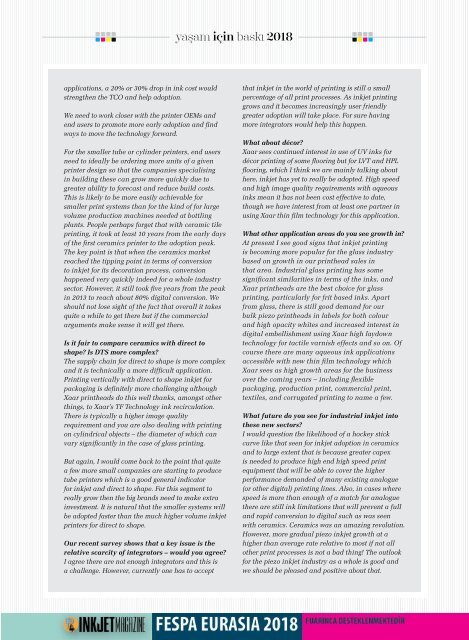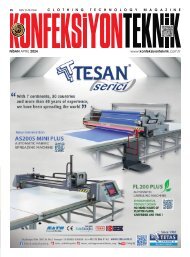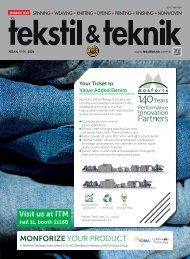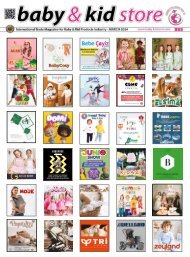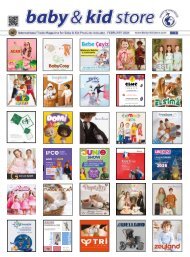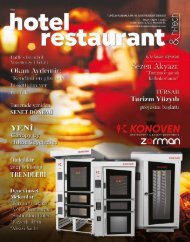You also want an ePaper? Increase the reach of your titles
YUMPU automatically turns print PDFs into web optimized ePapers that Google loves.
yaşam için baskı <strong>2018</strong><br />
applications, a 20% or 30% drop in ink cost would<br />
strengthen the TCO and help adoption.<br />
We need to work closer with the printer OEMs and<br />
end users to promote more early adoption and find<br />
ways to move the technology forward.<br />
For the smaller tube or cylinder printers, end users<br />
need to ideally be ordering more units of a given<br />
printer design so that the companies specialising<br />
in building these can grow more quickly due to<br />
greater ability to forecast and reduce build costs.<br />
This is likely to be more easily achievable for<br />
smaller print systems than for the kind of for large<br />
volume production machines needed at bottling<br />
plants. People perhaps forget that with ceramic tile<br />
printing, it took at least 10 years from the early days<br />
of the first ceramics printer to the adoption peak.<br />
The key point is that when the ceramics market<br />
reached the tipping point in terms of conversion<br />
to inkjet for its decoration process, conversion<br />
happened very quickly indeed for a whole industry<br />
sector. However, it still took five years from the peak<br />
in 2013 to reach about 80% digital conversion. We<br />
should not lose sight of the fact that overall it takes<br />
quite a while to get there but if the commercial<br />
arguments make sense it will get there.<br />
Is it fair to compare ceramics with direct to<br />
shape? Is DTS more complex?<br />
The supply chain for direct to shape is more complex<br />
and it is technically a more difficult application.<br />
Printing vertically with direct to shape inkjet for<br />
packaging is definitely more challenging although<br />
Xaar printheads do this well thanks, amongst other<br />
things, to Xaar’s TF Technology ink recirculation.<br />
There is typically a higher image quality<br />
requirement and you are also dealing with printing<br />
on cylindrical objects – the diameter of which can<br />
vary significantly in the case of glass printing.<br />
But again, I would come back to the point that quite<br />
a few more small companies are starting to produce<br />
tube printers which is a good general indicator<br />
for inkjet and direct to shape. For this segment to<br />
really grow then the big brands need to make extra<br />
investment. It is natural that the smaller systems will<br />
be adopted faster than the much higher volume inkjet<br />
printers for direct to shape.<br />
Our recent survey shows that a key issue is the<br />
relative scarcity of integrators – would you agree?<br />
I agree there are not enough integrators and this is<br />
a challenge. However, currently one has to accept<br />
that inkjet in the world of printing is still a small<br />
percentage of all print processes. As inkjet printing<br />
grows and it becomes increasingly user friendly<br />
greater adoption will take place. For sure having<br />
more integrators would help this happen.<br />
What about décor?<br />
Xaar sees continued interest in use of UV inks for<br />
décor printing of some flooring but for LVT and HPL<br />
flooring, which I think we are mainly talking about<br />
here, inkjet has yet to really be adopted. High speed<br />
and high image quality requirements with aqueous<br />
inks mean it has not been cost effective to date,<br />
though we have interest from at least one partner in<br />
using Xaar thin film technology for this application.<br />
What other application areas do you see growth in?<br />
At present I see good signs that inkjet printing<br />
is becoming more popular for the glass industry<br />
based on growth in our printhead sales in<br />
that area. Industrial glass printing has some<br />
significant similarities in terms of the inks, and<br />
Xaar printheads are the best choice for glass<br />
printing, particularly for frit based inks. Apart<br />
from glass, there is still good demand for our<br />
bulk piezo printheads in labels for both colour<br />
and high opacity whites and increased interest in<br />
digital embellishment using Xaar high laydown<br />
technology for tactile varnish effects and so on. Of<br />
course there are many aqueous ink applications<br />
accessible with new thin film technology which<br />
Xaar sees as high growth areas for the business<br />
over the coming years – including flexible<br />
packaging, production print, commercial print,<br />
textiles, and corrugated printing to name a few.<br />
What future do you see for industrial inkjet into<br />
these new sectors?<br />
I would question the likelihood of a hockey stick<br />
curve like that seen for inkjet adoption in ceramics<br />
and to large extent that is because greater capex<br />
is needed to produce high end high speed print<br />
equipment that will be able to cover the higher<br />
performance demanded of many existing analogue<br />
(or other digital) printing lines. Also, in cases where<br />
speed is more than enough of a match for analogue<br />
there are still ink limitations that will prevent a full<br />
and rapid conversion to digital such as was seen<br />
with ceramics. Ceramics was an amazing revolution.<br />
However, more gradual piezo inkjet growth at a<br />
higher than average rate relative to most if not all<br />
other print processes is not a bad thing! The outlook<br />
for the piezo inkjet industry as a whole is good and<br />
we should be pleased and positive about that.


